When is The Best and Worst Time to Visit Vietnam?
The best time to visit Vietnam – for a whole country experience – is between November and April.
But, in my opinion, to hone it down to the very best time to visit Vietnam that would be during March to April or later in the year during September and up to early in October
Alternately, the worst time to visit Vietnam – and so the months to avoid – would be from late October (when Central Vietnam’s typhoon season can wash out travel plans) and during December to January, when it is cold and damp in the north and along the central coast.
May through to August can be hot and ideal for the central region and its beautiful beaches, but the north is usually hot and stormy during this time while the south is in its full rainy season.
The above is of course a general summary as weather systems are becoming unpredictable.
To properly prepare for your trip to Vietnam and truly understand Vietnam’s expected weather patterns on a month by month basis do read on. In this post, I’ll give you a full explanation of not only the two differing monsoon weather systems that affect Vietnam month on month. I’ll also tell you which are the best months to visit Vietnam if you are looking to travel through the whole country in two or three weeks. See my travel tip below!
I’ll also relate to my own experiences of travel in Vietnam throughout the southern, central, and northern regions, and take a look at the best times to see Vietnam’s most popular tourist sites – together with dates of national holidays and the annual cultural festivals – that may effect and enrich your own visit to Vietnam.

MY VIETNAM TRAVEL TIP
If you have two to three weeks to visit Vietnam, I would suggest you plan a north-to-south route in March/April. I’d start in Hanoi and plan a day trip to Ninh Binh and also plan a couple of days to see Sapa or Cat Ba Island and to sail on Lan Ha and Ha Long Bay. Then travel down to the central region for Hue and to Danang and Hoi An. Then finish your tour of Vietnam in Ho Chi Minh City (Saigon) but taking a day out to sail on the Mekong Delta. Then, for some island time and sunshine and relaxation, head off to Phu Quoc.
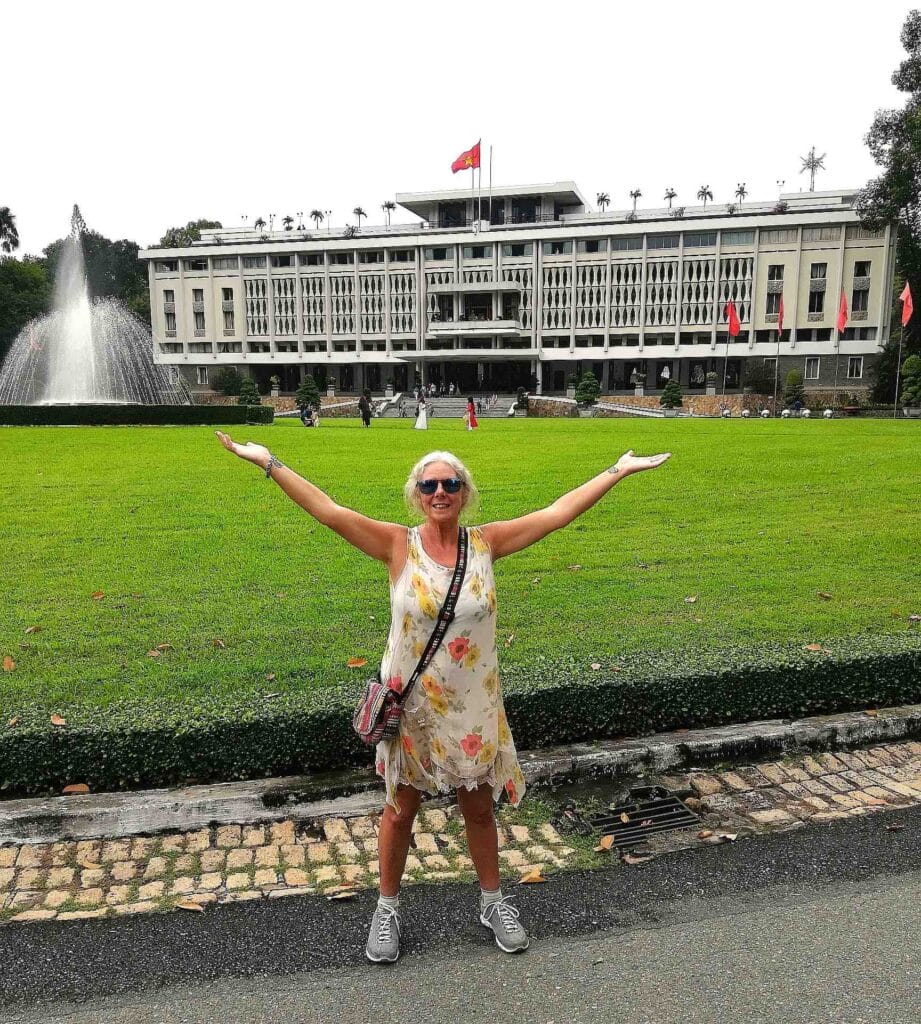
TABLE OF CONTENTS
- When is The Best and Worst Time to Visit Vietnam?
- MY VIETNAM TRAVEL TIP
- MY OWN TRAVELS IN VIETNAM
- A QUICK LOOK AT THE WEATHER SYSTEMS
- SIMPLE REGIONAL SUMMARY
- WHEN IS THE BEST AND THE WORST TIME TO VISIT VIETNAM
- QUICK MONTH-BY-MONTH WEATHER SUMMARY
- MY VISIT TO VIETNAM’S CENTRAL REGION
- MY VISIT TO VIETNAM’S SOUTHERN REGION
- MY VISIT TO VIETNAM’S NORTHERN REGION
- POPULAR TOURIST SPOTS IN VIETNAM AT A GLANCE
- THE BEST TIME TO VISIT ALL OF VIETNAM IN ONE TRIP
- IDEAL MONTHS FOR A WHOLE-COUNTRY ITINERARY
- TIMES TO AVOID FOR A WHOLE-COUNTRY ITINERARY
- WEATHER PATTERNS IN THE SOUTH OF VIETNAM
- WEATHER PATTERNS IN THE CENTRAL REGION OF VIETNAM
- WEATHER PATTERNS IN THE NORTH OF VIETNAM
- WHEN IS THE BEST AND WORST TIME TO VISIT VIETNAM?
- NATIONAL PUBLIC HOLIDAY DATES IN VIETNAM
MY OWN TRAVELS IN VIETNAM
I’m currently planning my third visit to Vietnam – one of my very favourite countries in the world – but in my experience, planning a trip to Vietnam can be a little tricky. It’s tricky because it’s a very long country that stretches over a thousand miles (1650 km) from north to south and this means the seasonal weather isn’t the same everywhere and all at once.
Vietnam’s weather is shaped by two main monsoons – the northwest monsoon and the southwest monsoon – and that means the different regions can have opposite weather at the same time. For example, you might be basking in hot sunshine on a beach in the south of the country, but Hanoi and Ninh Binh and Sapa in the north could be very cold and wet and misty.
But it’s the central region can be especially tricky, weather wise, with the most dramatic swings in weather.
So, each time I’ve planned to visit Vietnam, I’ve first taken into account which the three main regions – The South, The Central Coast, and The North – that I wanted to visit because each region has very different weather systems.
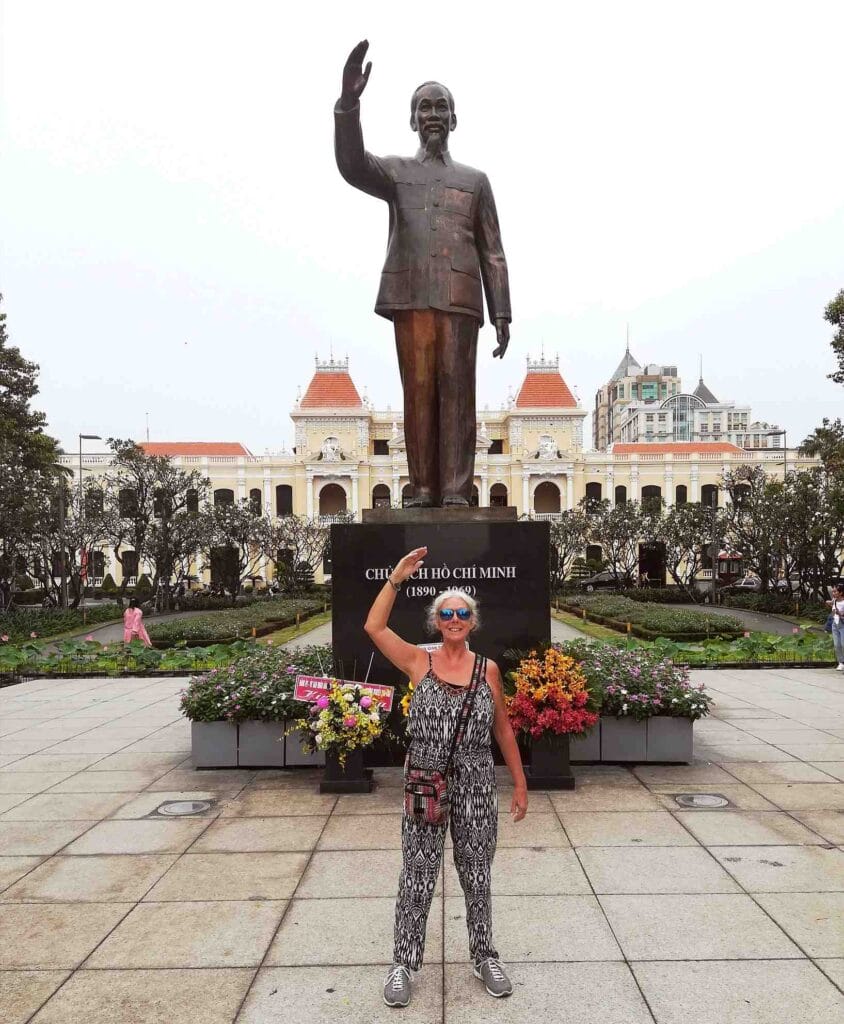
A QUICK LOOK AT THE WEATHER SYSTEMS
Northeast Monsoon (Nov to Mar):
Cool and dry winds from China make Northern Vietnam cool (it can get cold) and central and southern Vietnam dry and pleasant.
Southwest Monsoon (May to Oct):
Warm and wet winds from the Indian Ocean bring rainy season to most of the country and this means heavy downpours so it remains humid.
Transition months (Apr & Oct):
Weather is changing, can be mixed, often hot and humid.
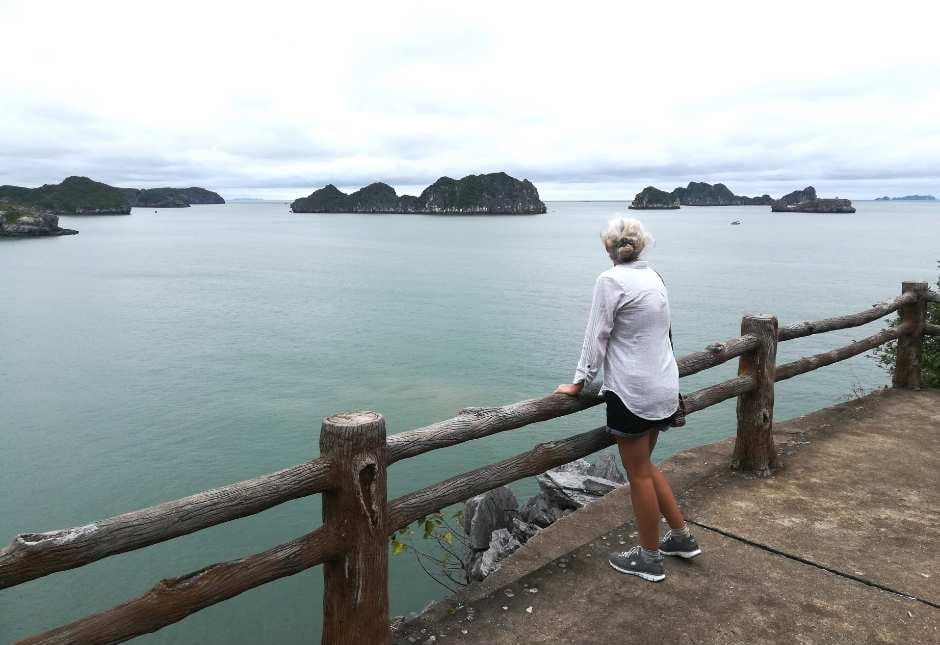
SIMPLE REGIONAL SUMMARY
North (Hanoi, Ha Long, Sapa): The northern region enjoys four seasons with a cold winter, hot summer, nice spring/autumn.
Central (Hue, Da Nang, Hoi An, Nha Trang): The central region generally has very hot and dry summers. It’s stormy in autumn time. Winter and spring time temperatures are mild.
South (Saigon, Mekong Delta, Phu Quoc): In contrast, the south has just two seasons. It’s dry from Nov to April and wet from May to Oct.

WHEN IS THE BEST AND THE WORST TIME TO VISIT VIETNAM
If you are still wondering when is the best and the worst time to visit specific regions in Vietnam – do read on – I will explain and share my own varied experiences of each of Vietnam’s main regions and what you can expect from expected weather patterns there month by month.
QUICK MONTH-BY-MONTH WEATHER SUMMARY
January – February: Great for the south, cool but damp in the north, rainy in central Vietnam.
March – April: Excellent for both the north and south; central region begins to dry up.
May – August: Best for beaches in the central region; rainy in the south; hot and stormy in the north.
September – November: Best time for the north; risky in the central region due to typhoons; wetter in the south.
December: Perfect for the south; chilly in the north; rainy in the central region.

MY VISIT TO VIETNAM’S CENTRAL REGION
My very first visit to Vietnam was to the Central Region and during the blisteringly month of August. I flew into Danang Airport and wanted to visit the beautiful old town of Hoi An.
I also wanted to spend time relaxing at the nearby beaches of An Bang and Cua Dai.
I’ve travelled to many hot and tropical countries over the past few years, but I honestly thought that experiencing Hoi An in August was the hottest temperatures that I’d ever endured!
We (my dear late husband and I) stayed in a lovely small hotel with good aircon in the rooms and a small shaded swimming pool in the garden. I’m so glad we chose a hotel with a swimming pool while staying in Hoi An because, at the end of a day exploring and walking the busy streets, it was so wonderful nice to cool off by floating about in the pool.
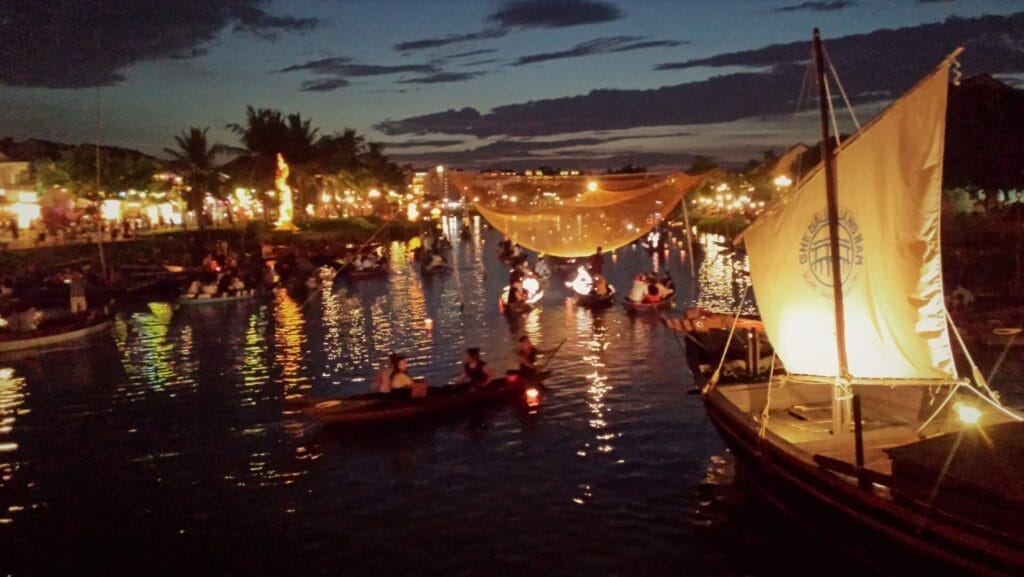
MY VISIT TO VIETNAM’S SOUTHERN REGION
My second visit to Vietnam was to the Southern Region during early March when the weather was perfect for exploring Hoi Chi Minh City (Saigon) and for taking a river cruise on the Mekong and to experience the Floating Village. In the south the temperatures are constant 25 – 35 degrees Celsius (75-95 Fahrenheit ) throughout the year.
MY VISIT TO VIETNAM’S NORTHERN REGION
After being in the South for ten days, I then flew from HCMC to Haiphong in the Northern Region of Vietnam. Here I was looking forward to explore Cat Ba Island, Lan Ha and Ha Long Bay.
The weather was pleasantly warm in the north and I found it to be refreshingly cooler than the bustling heat of Ho Chi Minh City. I then travelled on towards the Central Region – by train and via the beautiful Hai Van Pass – to the Royal City of Hue.
This time, for my third visit to Vietnam, I’m planning to fly into Hanoi in the North during the month of April. I haven’t been to Hanoi before and, while I’m there, I’m looking forward to exploring the Old Town and also taking a day trip from Hanoi to visit Ninh Binh. I am also planning to take a few days to travel by train even further north to the mountainous area of Sapa.

POPULAR TOURIST SPOTS IN VIETNAM AT A GLANCE
The South – Ho Chi Minh City, Mekong Delta, Phu Quoc Island
The Central Region – Hoi An, Da Nang, Hue, Nha Trang
The North – Hanoi, Halong Bay, Sapa, Ha Giang

THE BEST TIME TO VISIT ALL OF VIETNAM IN ONE TRIP
In travelling to the Northern Region in the month of April, I will be expecting the temperatures in Hanoi to be mild and (I’m hoping) that the air pollution for which the city is unfortunately renowned, will be lower than in the heat of the later months.
The mountain air in Sapa should be cool and hopefully dry and not too misty to obstruct the spectacular mountain views.
If your goal is to experience the North, Central, and South in a single journey, then you’ll certainly want to choose a time of year when conditions align across the whole country.
In Vietnam, while no month is flawless everywhere, some are much better than others.
So, to help you plan your itinerary for your own dream trip to Vietnam and to fully answer your question of When Is The Best and Worst Time To Visit Vietnam, here’s my month-by-month breakdown, my travel tips, and a deeper look at each regions expected weather patterns.

IDEAL MONTHS FOR A WHOLE-COUNTRY ITINERARY
March to April
North: Spring blossoms, mild temperatures in Hanoi, and great trekking in Sapa.
Central: The rains ease off, beaches in Da Nang and Hoi An start shining.
South: Dry, sunny skies — perfect for Phu Quoc or cruising the Mekong.
Overall: A golden window with minimal weather issues across all regions.
September to Early October
North: Crisp autumn skies, golden rice terraces in Sapa and Ha Giang, perfect for Halong Bay.
Central: Still warm and sunny in early September, but by October, the risk of typhoons rises.
South: Rainy season tapering off, gradually improving toward November.
Overall: Excellent for northern highlights and culture-rich cities like Hanoi and Hue. Slightly riskier for the central coast.
TIMES TO AVOID FOR A WHOLE-COUNTRY ITINERARY
October (especially mid–late October): Central Vietnam’s typhoon season can wash out travel plans.
December – January: Cold, damp north + rainy central coast = not ideal unless you only want southern sunshine.
May – August: Great for the central beaches, but the north is hot and stormy, and the south is in full rainy season.
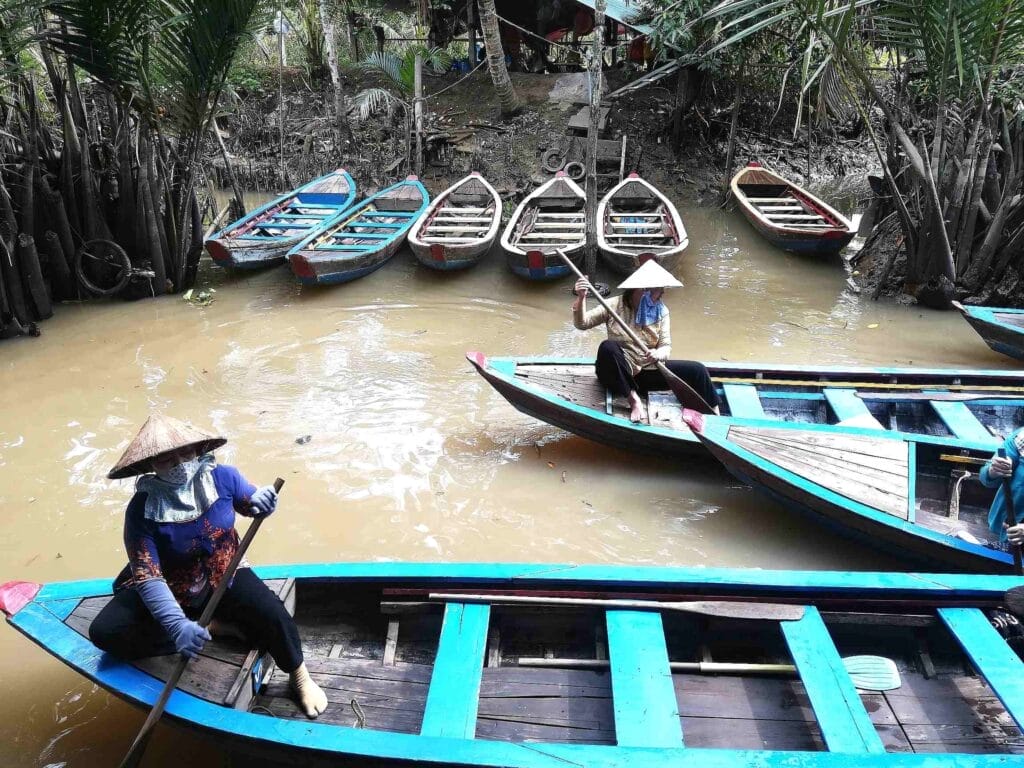
WEATHER PATTERNS IN THE SOUTH OF VIETNAM
(Ho Chi Minh City, Mekong Delta, Phu Quoc)
Weather Patterns: The south is tropical year-round, with two clear seasons:
Dry season: December to April (sunny, hot, lower humidity)
Rainy season: May to November (afternoon downpours, humid, greener landscapes)
Best Time to Visit
December – April: This is perfect for exploring Ho Chi Minh City’s energy, cruising the Mekong Delta, or unwinding on the beaches of Phu Quoc. Expect clear skies and lots of sunshine.
Tougher Months
May – September: Frequent rain showers, especially in the afternoons. It doesn’t usually ruin your day, but beach lovers may find it less ideal.
October: Peak rainfall and occasional flooding make this the least convenient and worst time to visit the south.

WEATHER PATTERNS IN THE CENTRAL REGION OF VIETNAM
(Hoi An, Da Nang, Hue, Nha Trang)
Weather Patterns: Central Vietnam has the most dramatic swings in weather:
Dry season: February to August (sunny, hot, beach-friendly)
Rainy/typhoon season: September to January (heavy rain, storms possible)
Best Time to Visit
February – August: Excellent for strolling through the lantern-lit streets of Hoi An, exploring imperial history in Hue, or beach hopping in Da Nang and Nha Trang.
Tougher Months
September – November: The central coast can be hit by typhoons, especially around Hue and Hoi An. Roads sometimes flood, and outdoor activities can be disrupted.
December – January: Rain continues, though less intense. Still not the best for beach trips.
WEATHER PATTERNS IN THE NORTH OF VIETNAM
(Hanoi, Halong Bay, Sapa, Ha Giang)
Weather Patterns: The north has four distinct seasons, making it feel very different from the rest of the country:
Spring (March – April): Mild, misty, pleasant.
Summer (May – August): Hot, humid, heavy rains.
Autumn (September – November): Crisp, cool, beautiful skies.
Winter (December – February): Cold, especially in the mountains.
Best Time to Visit
September – November: Arguably the most beautiful time of year. Hanoi enjoys blue skies, Halong Bay sparkles, and trekking in Sapa or Ha Giang is at its best with golden rice terraces.
March – April: Another lovely window, with comfortable temperatures and blooming flowers.
Tougher Months
May – August: High humidity, heavy rain, and the risk of tropical storms in Halong Bay.
December – January: It can be surprisingly cold in Hanoi and downright freezing in Sapa. If you weren’t expecting winter coats, it might not be ideal.
WHEN IS THE BEST AND WORST TIME TO VISIT VIETNAM?
Best Overall Months: March – April and September – November give you the best balance if you want to see multiple regions.
Best for Beach Lovers: May – August (central coast).
Worst Times: October in the central region (typhoons) and December – January in the north (cold and grey).
If you’re planning a trip across all three regions, it’s almost impossible to get ‘perfect’ weather everywhere at once. Decide what matters to you the most – is it the beaches, the countryside and trekking opportunities, or city exploring. Plan your trip by your personal priorities.
Month-by-month chart showing the best and worst times to visit Vietnam by region.

NATIONAL PUBLIC HOLIDAY DATES IN VIETNAM
Depending on your views about national holidays, festivals, and cultural celebrations – a time to visit or a reason to avoid – these are the usual times of year for the most important of Vietnam’s national holidays and celebrations.
On national public holidays in Vietnam, many government offices, banks, and some services may close. Private businesses and tourist facilities may remain open but with reduced hours.
Major Festivals, Cultural & Religious Events
These are not always public holidays, but many of them are deeply important, lively, and regionally significant. As a tourist, attending them can be a highlight or occasionally a challenge due to crowds, closures, or transport bottlenecks.
In the following month by month list of Vietnam Holidays & Festivals I have shown the dates for 2025 as an example – but please note – that dates of lunar-calendar events shift each year.
Always check the dates of these holidays for the specific year that you plan to travel.
January
1 Jan – New Year’s Day (Tết Dương Lịch)
28 Jan – 3 Feb – Tết (Vietnamese Lunar New Year, multi-day public holiday)
February
10 Feb – Tết Nguyên Tiêu (First Full Moon Festival)
10 – 11 Feb – Lim Festival (Bắc Ninh, Quan Họ folk singing)
Feb – May – Perfume Pagoda Festival (pilgrimage season in Hanoi area)
March
8 Mar – International Women’s Day
31 Mar – Tết Hàn Thực (Cold Food Festival)
31 Mar – 5 Apr – Phủ Dầy Festival (Nam Định province, goddess worship)
April
4 Apr – Thanh Minh Festival (Tomb-sweeping Day)
7 Apr – Hùng Kings’ Commemoration Day (public holiday)
14 – 16 Apr – Chol Chnam Thmay (Khmer New Year, southern Khmer communities)
30 Apr – Reunification / Liberation Day (public holiday)
May
1 May – International Labor Day (public holiday)
5 May (lunar 5th month) – Tết Đoan Ngọ (Mid-year Festival/Pestilence-warding Day)
5 – 12 May – Vesak (Buddha’s Birthday, observed at temples)
June
Ongoing — Perfume Pagoda Festival continues until early June
June – July – Da Nang International Fireworks Festival (dates vary/weekends)
July
8 Jul (15th day of 6th lunar month) – Vu Lan Festival (Wandering Souls/Ghost Festival)
September
2 Sep – National Day (public holiday)
6 Sep – Mid-Autumn Festival (Tết Trung Thu)
October
20 Oct – Vietnamese Women’s Day
November
20 Nov – Vietnamese Teachers’ Day
December
24 Dec – Christmas Eve (widely celebrated, not an official holiday)
25 Dec – Christmas Day (Christian communities, festive in major cities)
I hope both my summary and full explanation of Vietnam’s complicated weather patterns has helped you to plan your own trip to Vietnam.
It is tricky to plan a trip that will encompass the whole country unless you do plan carefully.
Because the fact that the country geographical is very long and coastal and is affected by two different and opposing monsoon systems – that can at certain times of year and under certain condition bring dangerous folding and typhoons – really do make it prudent to plan properly.
Have you visited Vietnam?
Are you planning to visit?
What month are you favouring and to which region/s?
Has this post been helpful to you?
the backpacking housewife recommends travel insurance


